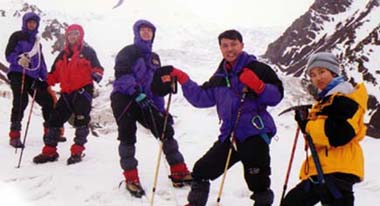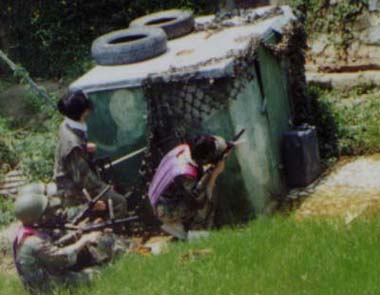|
Live out the excitement Life is exciting when people share their experiences By Kyle Hung and Chloris Ho |
Courtesy of Diana Choi |
|
This project was organised by the Centre for Physical Education and Sports at the University of Hong Kong. Participants came from the seven universities in Hong Kong, Tsinghua University, Beijing University, and Changchun Science and Technology University. Hong Kong students started climbing from the southern part of Yu Zhu Feng, while their Mainland counterparts started from the north. They aimed at meeting at the summit on 1 July to coincide with the return of sovereignty of Hong Kong to China. Explained Mr. Simon Lo, the team manager: “The objective of the project was to enhance interaction between undergraduate students in Hong Kong and China through mountaineering.” Although the expedition lasted only three weeks, the students took a whole year planning and training. The climate at high altitudes changes rapidly and unpredictably. “It’s like we were experiencing the four seasons in one day. “The weather is so different from that of Hong Kong that we felt very uncomfortable at first,” said Diana Choi, a Year 2 student at Hong Kong Polytechnic University. Carrying heavy equipment, team members had to move slowly and rest every five paces. The thinness of air was another problem. They had to breathe rhythmically to get more oxygen from the almost oxygen-free air. One of the participants, Ben Chan, suffered from high-altitude sickness. Besides headaches and sleeplessness, Ben also experienced loss of appetite and vomiting. “Generally speaking, male team members suffered from high-altitude disease more,” said Ben. The heavy equipment and thick, insulating clothing created problems of personal hygiene because it was difficult to dress and undress. “We didn’t have a shower for more than 10 days. “The hygienic conditions subsequently worsened,” said Teresa Mok, a Year 2 student at The Chinese University of Hong Kong. Compared with a blizzard that struck on the night of 30 June, when the team was going to climb the mountain, the other problems seemed trivial. While the blizzard assaulted them, the first team returned to the campsite. But three team members — one Hong Kong student and two Tsinghua University students — were missing because they could not keep up with others going down the mountain. The team manager asked the backup team to look for them the next morning. Fortunately, there was a backup campsite in the middle of the mountain. The three missing members were found there. This accident taught the students a lesson. Diana said, “Through this expedition, I realise that support and cooperation are very important.” There were reasons for the students to finish the tough mission. Diana hoped to challenge herself and to test her physical limits through this rare opportunity. Teresa found the experience unusual and treasurable. The Centre for Physical Education and Sports at Hong Kong University is planning to launch another mountaineering project in 2000. “We hope students from Hong Kong, Taiwan, Macau and China will volunteer to climb a 6,000-metre mountain near Chang Jiang next time together,” said Mr. Lo, team manager. War in time of peace Bruises are symbols of a painful but engaging experience for war game participants. “I am sure those who leave the war game battlefield without any bruises must have hidden in some secret places all day long,” said Mr. Fred Lau, a trainer at War Games — Leadership and Management Training Centre. There are two groups in the game, from 20 to 60 participants in each group. Participants in military fatigues run around the centre’s 42,000-square-foot site in Tai Po. The weapons are semiautomatic air guns with paint-filled pellets. Explained Mr. Lau: “Participants have limited ‘bullets’, time and hiding places. “They have to make use of their limited resources to finish their mission.” |
Courtesy of War Games - Leadership & Management Training Centre |
|
To improve the employees’ leadership and management skills, corporations such as banks, hotels, restaurants and management companies send employees for training at the centre. Ms Katrina Ng joined the game when the centre held a promotion in her company. “We had to plan well before moving,” said Ms Ng, who now has 3 years’ experience. “In what direction to shoot at opponents, and at what time, has to be planned beforehand.” Arrangements for staking out territory and the position of each member are important. Sometimes, people have to shield other members when attacking opponents. “The leader of the group makes the overall orders,” said Ms Ng. “However, some may not listen to the leader and remain in their positions without any response. “Anything can go wrong during a war game,” she said. Kart racing at speed “My body is attuned into the kart,” said Mr. Andy Chan, a committee member of the Hong Kong Kart Club. “When the kart rushes smoothly along the track, I am rushing together with the kart. The feeling is really wonderful.” Kart racers dress in racing suits and wear gloves, goggles and a specially manufactured crash helmet. “The kart’s speed is high, and I can exert complete control over it,” said Mr. Chan, a kart racer for 20 years. Kart racing is considered an entry sport to motor racing. People age above 11 can apply for a competition license. Without a license, people are not allowed to race. Participants are gradually promoted from a restricted license class to an international license class. Second-hand karts and engines can be purchased for as little as $8,000. Engines used by top international drivers cost up to $30,000. When making turns, kart racers have to twist their waists and their necks to withstand the centrifugal force. Poor control of the accelerator pedal can result in lost of control. “My first kart experience was tough. I was extremely tired after my first race. The kart kept shocking and my heart nearly popped out when I was turning at a corner,” said Mr. Chan. |
 Art
Art
December 1997
[Editorial] [Letters] [Answer] [News] [Social] [Photo] [Culture] [Education] [Channels] [Science] [Celebrity]
Comments Editor-in-Chief Electronic Editor